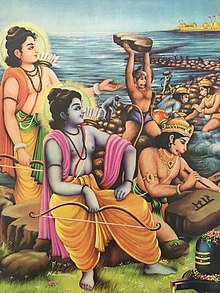Vanara
In the Vanara form, they had beards with extended sideburns, narrowly shaved chin gap, and no moustache.
[9] The Ramayana presents them as humans with reference to their speech, clothing, habitations, funerals, weddings, consecrations etc.
[8] Aiyanagar suggests that though the poet of the Ramayana may have known that vanaras were actually forest-dwelling people, he may portrayed them as real monkeys with supernatural powers and many of them as amsas (portions) of the gods to make the epic more "fantastic".
Taking Brahma's orders, the gods began to parent sons in the zion of Kishkindha (identified with parts of present-day Karnataka, Andhra Pradesh, and Maharashtra).
As described in the epic, the characteristics of the Vanara include being amusing, childish, mildly irritating, badgering, hyperactive, adventurous, bluntly honest, loyal, courageous, and kind.
For example, while he searches for the kidnapped Sita in Ravana's palaces on Lanka, he contracts himself to the size of a cat, so that he will not be detected by the enemy.





